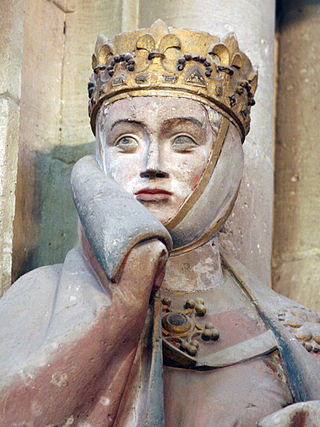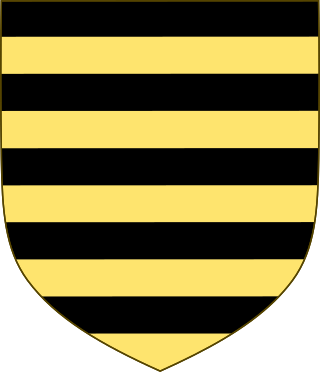Related Research Articles
The House of Ascania was a dynasty of German rulers. It is also known as the House of Anhalt, which refers to its longest-held possession, Anhalt.

The Duchy of Anhalt was a historical German duchy. The duchy was located between the Harz Mountains in the west and the River Elbe and beyond to the Fläming Heath in the east. The territory was once ruled by the House of Ascania, and is now part of the federal state of Saxony-Anhalt.

Ballenstedt is a town in the Harz district, in the German state of Saxony-Anhalt.
Gertrud of Brunswick was Countess of Katlenburg by marriage to Dietrich II, Count of Katlenburg, Margravine of Frisia by marriage to Henry, Margrave of Frisia, and Margravine of Meissen by marriage to margrave Henry I.
Eilika of Saxony was a daughter of Magnus, Duke of Saxony and a member of the Billung dynasty. Through marriage to Otto of Ballenstedt, she was countess of Ballenstedt.

The Principality of Anhalt was a State of the Holy Roman Empire, located in Central Germany, in what is today part of the federal state of Saxony-Anhalt.

Otto II, called The Generous, was the third Margrave of Brandenburg from 1184 until his death.

Gernrode Abbey was a house of secular canonesses (Frauenstift) in Gernrode in what is now Saxony-Anhalt, Germany. Gernrode was founded in 959 and was disestablished in the seventeenth century. In the Middle Ages the abbey was an Imperial abbey, which had the status of imperial immediacy, and an Imperial State. In the early modern period, the abbey was part of the Upper Saxon Circle.

Anhalt Castle is a ruined medieval fortification near the town of Harzgerode in Saxony-Anhalt, Germany.

The Schwabengau was an early medieval shire (Gau) in the Eastphalia region of the medieval Duchy of Saxony. Ruled by the House of Ascania, it became the nucleus of the later Principality of Anhalt, today part of the German state of Saxony-Anhalt.
Albert II was a member of the House of Ascania who ruled as the margrave of Brandenburg from 1205 until his death in 1220.

Uta von Ballenstedt, a member of the House of Ascania, was Margravine of Meissen from 1038 until 1046, by marriage to Margrave Eckard II. She is also called Uta of Naumburg as the subject of a famous donor portrait by the Naumburg Master.

John II, Margrave of Brandenburg-Stendal was co-ruler of Brandenburg with his brother Otto "with the arrow" from 1266 until his death. He also used the title Lord of Krossen, after a town in the Neumark.

Matilda of Swabia, a member of the Conradine dynasty, was Duchess of Carinthia by her first marriage with Duke Conrad I and Duchess of Upper Lorraine by her second marriage to Duke Frederick II. She played an active role in promoting her son, Duke Conrad the Younger, as a candidate for the German throne in 1024 and to this end corresponded with King Mieszko II Lambert of Poland.

Hazecha of Ballenstedt was a member of the House of Ascania, and the third abbess of Gernrode (r.1044-1063).

Siegfried I of Ballenstedt, was the son of Adalbert II of Ballenstedt, and a member of the House of Ascania. He was count palatine of the Rhineland (r.1095/7-1113), and count of Weimar-Orlamünde (r.1112-1113).
Adelaide of Ballenstedt was the daughter of Otto of Ballenstedt and a member of the House of Ascania. She married, successively, Henry IV, Count of Stade, and Werner, Count of Osterburg.
Gertrude of Northeim, was a German noblewoman and regent.
Adalbert von Ballenstedtc. 970,, was Count of Ballenstedt, Vogt of the Nienburg Abbey, and the provost of Hagenrode. He is the earliest known ancestor of the House of Ascania.
References
- ↑ Partenheimer, Albrecht der Bär, p. 22.
- 1 2 3 4 5 Schlenker 2012 p29-30
- 1 2 Feicker 2012, p16
- ↑ Feicker 2012, p15
- ↑ Partenheimer, Albrecht der Bär, p. 20; Assing, Die frühen Askanier, pp. 6f.
- ↑ Codex diplomaticus Anhaltinus, I, nos. 111 (1036); 112 (1041); 115 (1043); 116 (1043); 116a (1043); 117 (1043); 122 (1046); 129 (1051); 16 (1059).
- ↑ Annalista Saxo, a.1025, p. 337.
- ↑ Partenheimer, Albrecht der Bär, pp. 20f.
- ↑ Schmarsow, August. Die Bildwerke des Naumburger Domes. Ev Flottwell, 1892. p21
- ↑ Elke Haan, Kompass Wanderführer Harz: 50 Touren. Mair Dumont DE, May 15, 2015 p104
- ↑ Peter Feist: Burg Anhalt - Der Ort, der dem Land den Namen gab. Kai Homilius Verlag, Berlin 1997
- ↑ Thiele, Erzählende genealogische Stammtafeln, table 217.
- ↑ Annalista Saxo, a.1026, p. 363.
- ↑ Schlenker 2012 p32.
- ↑ Mohr, Geschichte, pp. 77-80.
- ↑ Trillmich, Kaiser Konrad II, p. 79.